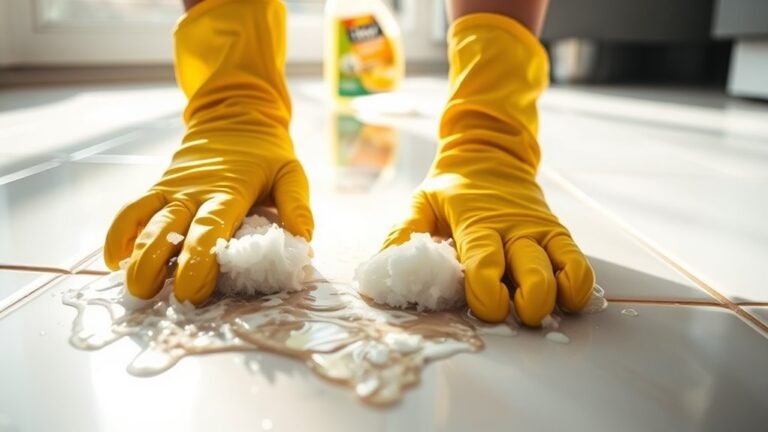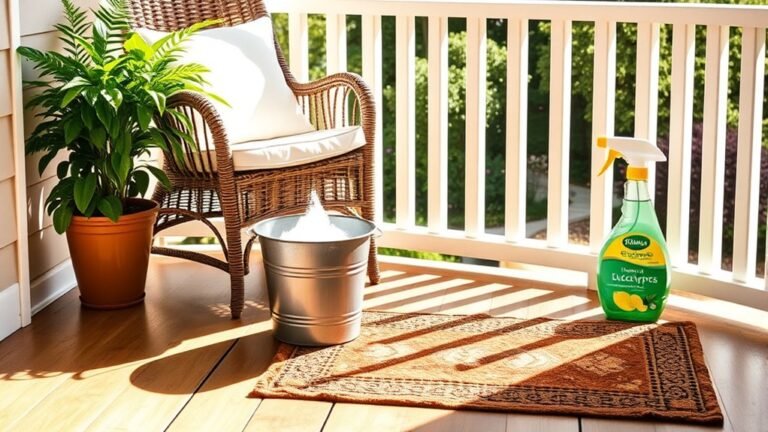How to Remove Gum From Carpets and Furniture
To remove gum from carpets or furniture, start by freezing it with ice cubes in a bag to harden the gum and reduce stickiness. Then gently lift the gum with a blunt tool. For residue, dab vinegar or rubbing alcohol on the spot and blot carefully to avoid fabric damage. Always test solutions on hidden areas first. Want to keep your space gum-free and learn safer, more effective ways? There’s plenty more helpful info ahead.
Identifying the Type of Gum and Surface

How can you tell what kind of gum you’re dealing with and what surface it’s stuck to? First, recognize that different gum types—chewing gum, bubble gum, or sugarless gum—each behave uniquely. Chewing gum often becomes sticky and pliable, while bubble gum tends to be softer and more elastic. Next, consider the surface materials involved. Carpets with dense fibers trap gum deeper, while furniture upholstery varies widely—leather is sensitive and needs gentler care, whereas fabric may absorb gum more readily. Identifying both the gum type and surface materials helps you choose the best removal method without damaging your belongings. By understanding these variables, you’re taking control, freeing yourself from frustration, and setting the stage for effective gum removal without compromising your cherished carpet or furniture.
Freezing the Gum for Easy Removal
When gum sticks to your carpet or furniture, freezing it makes removal much easier. By solidifying the gum, you reduce its stickiness, making it less likely to damage your surfaces. Different gum types respond well to various freezing methods, so choose the one that fits your situation best.
Freezing gum solidifies it, reducing stickiness and preventing damage to carpets and furniture for easier removal.
Here are some effective freezing methods:
- Place ice cubes in a plastic bag and hold it on the gum for 15-20 minutes.
- Use a can of compressed air turned upside down to freeze the gum instantly.
- For small furniture pieces, you can move them to a freezer temporarily.
- Wrap the area with a cold pack designed for injuries if you want a reusable option.
Freezing gum gives you the freedom to remove it cleanly without harsh chemicals.
Using Household Solutions to Loosen Gum

Once the gum has hardened through freezing, you can turn to common household solutions to further loosen it from your carpet or furniture. One effective approach is the ice method, where you apply ice cubes in a plastic bag directly onto the gum to keep it solid and brittle. This helps you scrape it off without smearing. Another powerful option is using a vinegar solution—mix equal parts white vinegar and water, then dab it onto the gum. The acidity breaks down the gum’s stickiness, making it easier to lift away. Both methods give you the freedom to tackle gum without harsh chemicals, using what you likely already have at home. With patience and these simple tricks, you’ll regain your clean space in no time.
Removing Residue Without Damaging Fabric
Although you’ve managed to lift most of the gum, sticky residue can still cling to your carpet or furniture. When tackling this, you want an alternative removal method that respects the fabric care your belongings deserve. Avoid harsh scrubbing, which can damage fibers, and opt for gentle techniques instead.
Try these steps for residue removal without harm:
- Dab the area with a cloth dipped in rubbing alcohol or vinegar to break down stickiness.
- Use a soft-bristled brush to loosen residue carefully.
- Test any solution on a hidden spot first to avoid discoloration.
- Blot, don’t rub, to lift residue while preserving fabric integrity.
With patience and the right approach, you’ll free your fabrics without sacrifice.
Preventative Tips to Avoid Future Gum Stains

Keeping gum off your carpets and furniture is much easier than removing it later. To enjoy your space freely, adopt effective gum prevention strategies. First, always chew gum away from carpeted or upholstered areas to minimize accidental drops. Teach kids and guests about these boundaries to keep your home gum-free. Next, practice safe storage by sealing gum packs tightly and storing them out of reach of children and pets. This simple step reduces temptation and accidental spills. Finally, consider replacing gum with alternatives like mints or toothpicks when indoors, eliminating risk altogether. By following these straightforward tips, you maintain a clean environment and the freedom to relax without worrying about sticky messes ruining your carpets or furniture. Prevention is your best defense.
Frequently Asked Questions
Can Chewing Gum Cause Permanent Damage to Carpet Fibers?
You might wonder if gum types can cause permanent damage to your carpet fibers. While some gums are stickier and harder to remove, they usually don’t ruin your carpet if you act quickly. With good carpet maintenance, you can keep your space looking fresh and free from stubborn stains. Just remember, the longer gum sits, the tougher it gets, so tackling it promptly is your best bet to protect your freedom and style.
Is It Safe to Use Commercial Gum Removers on All Furniture Types?
You’ll want to be cautious with commercial product safety when using gum removers, as not all are safe for every furniture type. Different materials react differently, so furniture material compatibility is key. Always test a small, hidden area first to avoid damage or discoloration. By doing this, you keep your freedom to restore your furniture without risking harm, ensuring the product works well with your specific pieces before fully applying it.
How Long Does It Take for Gum to Harden Enough to Freeze?
Ever wondered how long it takes for gum to freeze solid? Typically, the gum freezing time is about 15 to 30 minutes in a standard freezer. This quick hardening makes gum removal methods much easier, freeing you from sticky situations. If you’re aiming for freedom from stubborn gum, patience during this freezing phase is key. Just pop the item in the freezer, wait a bit, and then gently scrape away without damage.
Are There Eco-Friendly Alternatives to Chemical Gum Removal Products?
You’ll find plenty of natural gum removers that let you ditch harsh chemicals and still get the job done. Biodegradable solutions like vinegar, baking soda paste, or even ice cubes are gentle on the environment and effective at loosening gum. These options give you freedom from toxins while keeping your space clean and green. So, go ahead and choose eco-friendly methods—they’re kind to the planet and just as reliable.
Can Pets Be Harmed by Ingesting Gum Residue From Carpets?
You’d think pets could survive a gum apocalypse, but gum toxicity is a serious risk you shouldn’t ignore. If your furry friend snags gum residue from carpets, it can cause choking, intestinal blockages, or even poisoning from sweeteners like xylitol. For pet safety, always clean gum thoroughly and keep your freedom intact by preventing accidental ingestion. Protect your pets by being vigilant—it’s the best way to keep them safe and happy.






